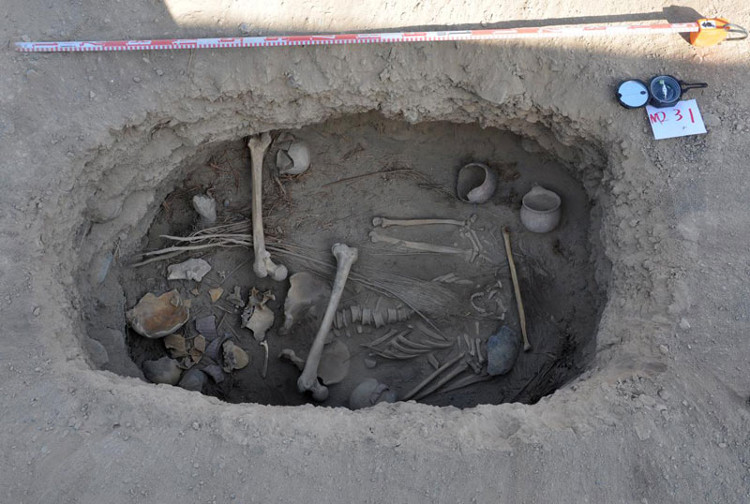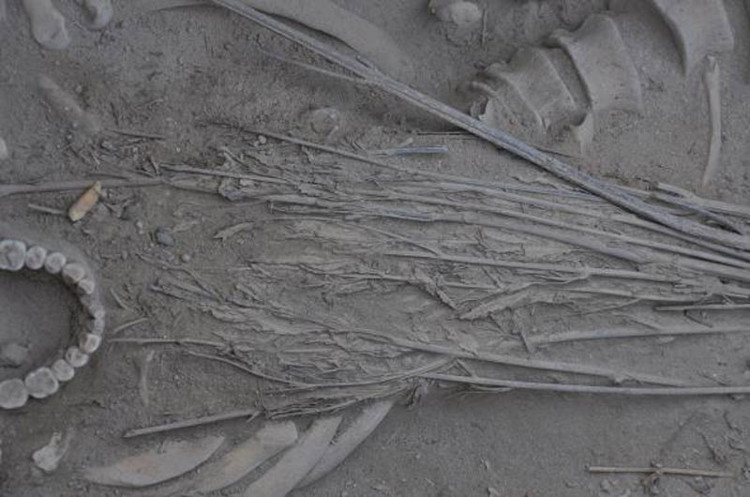Discovering the burial custom of marijuana in a 2,500-year-old tomb
Recently, Chinese archaeologists excavated an ancient tomb and discovered a dead body of about 2,500 years old. Notably, this human skeleton is covered with a layer of cannabis like a shroud.
In a report published recently in the journal Economic Botany, archaeologist Hongen Jiang and his colleagues described the process of burying an 35-year-old adult in Turpan, northwestern China. .

The cannabis plant is located on the body of a middle-aged man about 35 years old in the tomb of 2,500 years in Turpan, China.
It is known that this corpse was buried about 2,400 - 2,800 years earlier. Remarkably, the corpse was placed on a wooden bed, resting on a reed pillow and covered with a layer of marijuana. Specifically, there are 13 marijuana plants covered on corpses, each of which is about 0.91m long and is crossed from the pelvis to the chin, slightly to the left side of the face.
According to National Geographic, this is the first time archaeologists can fully restore cannabis from an ancient human tomb. At the same time, the discovery of this corpse was also the first time the cannabis plant was used as a shroud. This opens us up to a new burial burial custom in ancient Eurasian culture.

Marijuana plants have a completely intact state.
"This archaeological evidence shows us that, thousands of years ago, the use of marijuana was very popular in Eurasian prairies," said Hongen archaeologist Hongen.
- New discovery about the custom of burial in the ice age
- Excavation of 800-year-old tomb, unexpectedly discovered precious treasures
- Incense furnace containing marijuana in the tomb of 2,500 years in China
- Perverted customary burial of children in the trunk
- Unusual burial practices in Tibet
- The secret of an ancient tomb is 800 years old in China
- Discovered a 2,000-year-old ancient tomb in Central China
- Strangely, burial of dead people lasted for years
- 4,000 year old tombs in Xinjiang
- An odd ancient tower tomb population in Peru
- Ancient tombs are full of Chinese emperor's treasures
- Mysterious discoveries in the Middle Ages
 Discovered an ancient centipede fossil 99 million years old
Discovered an ancient centipede fossil 99 million years old Discovered bat-like dinosaurs in China
Discovered bat-like dinosaurs in China Discovered a 200-year-old bronze cannon of the coast
Discovered a 200-year-old bronze cannon of the coast Discover 305 million-year-old spider fossils
Discover 305 million-year-old spider fossils World's most powerful telescope captures something that threatens to upend cosmology
World's most powerful telescope captures something that threatens to upend cosmology  'Time-traveling assassin' 13 billion years ago kills an entire galaxy
'Time-traveling assassin' 13 billion years ago kills an entire galaxy  The mystery of human lifespan limits
The mystery of human lifespan limits  13 'alien' skulls next to Mayan pyramids
13 'alien' skulls next to Mayan pyramids  How long does it take to reach another star system besides the Solar System?
How long does it take to reach another star system besides the Solar System?  For the first time, 5 super-objects from 13.6 billion years ago have been revealed.
For the first time, 5 super-objects from 13.6 billion years ago have been revealed. 